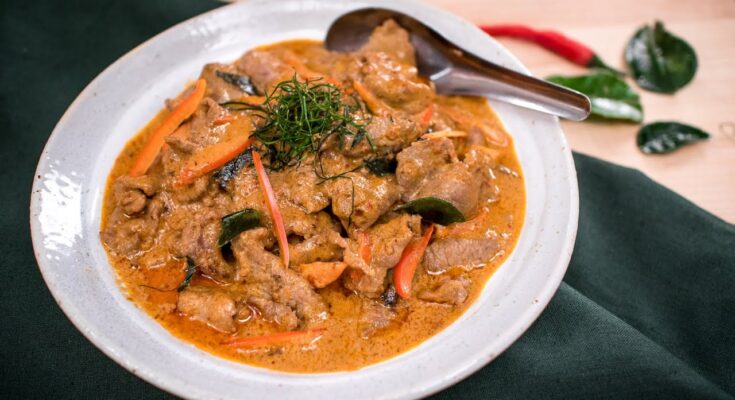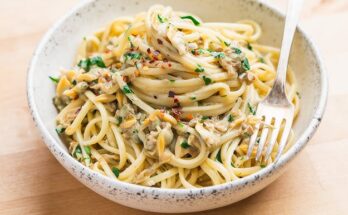Panang Curry Recipe: Panang curry is a rich, creamy, and flavorful Thai dish that has captured the hearts of food lovers worldwide.
Its unique blend of sweet, salty, and spicy flavors, combined with the creamy goodness of coconut milk, makes it a favorite on restaurant menus and dinner tables alike.
Whether you’re new to cooking or a seasoned chef, this step-by-step guide will help you create a Panang curry that tastes as good as the one from your favorite Thai restaurant.
Ingredients for Panang Curry
Essential Ingredients
To make a delicious Panang curry, you’ll need the following key ingredients:
- Protein options: Chicken, beef, or tofu are commonly used. Each adds its unique texture to the curry.
- Vegetables: Bell peppers, zucchini, and green beans work well, providing crunch and nutrition.
- Panang curry paste: This is the heart of the dish, made from a blend of spices, herbs, and chilies. Look for authentic Thai brands or make your own for the best flavor.
Additional Ingredients for Authentic Flavor
To achieve the true taste of Panang curry, add:
- Coconut milk: The creamy base of the curry, balancing the heat of the paste.
- Kaffir lime leaves: Adds a distinct citrusy aroma and flavor.
- Palm sugar or brown sugar: Provides sweetness that balances the spicy and salty elements.
Optional Garnishes
- Thai basil for a fresh, herbal touch.
- Crushed peanuts for a crunchy, nutty finish.
Tools and Utensils You’ll Need
Before you start cooking, gather these essential tools:
- A wok or deep pan for even cooking.
- A mortar and pestle if you plan to make your curry paste from scratch.
- A sharp knife and sturdy cutting board for prepping ingredients.
How to Make Panang Curry Recipe – Step by Step Guide
Step 1 – Preparing the Ingredients
Start by prepping everything you’ll need:
- Protein: If using chicken or beef, slice it into thin strips for quicker cooking. For tofu, cut it into cubes and pat dry to remove excess moisture.
- Vegetables: Wash and slice vegetables into bite-sized pieces.
- Curry paste: If using store-bought paste, measure the amount needed. For homemade paste, crush chilies, garlic, and spices into a smooth mixture.
Step 2 – Making the Base
Creating a flavorful base is crucial for Panang curry:
- Heat a tablespoon of oil in your wok over medium heat.
- Add the curry paste and stir continuously for 1-2 minutes until fragrant.
- Slowly pour in coconut milk while stirring to combine it with the paste. This step ensures a smooth and creamy base.
Step 3 – Cooking the Protein and Vegetables
Now, it’s time to add the main ingredients:
- Add the sliced protein to the wok and cook for about 5-7 minutes, or until fully cooked.
- Toss in the vegetables, starting with the ones that take longer to cook, like green beans, followed by softer vegetables like bell peppers.
Step 4 – Balancing the Flavors
Taste and adjust the seasoning:
- Add a teaspoon of fish sauce or soy sauce for saltiness.
- Stir in a tablespoon of palm sugar for sweetness.
- Add a splash of lime juice for acidity.
Step 5 – Simmering for Depth of Flavor
Lower the heat and let the curry simmer for 10-15 minutes. This allows the flavors to meld beautifully and the sauce to thicken slightly. Stir occasionally to prevent sticking.
Step 6 – Serving the Panang Curry
Presentation is key to making your Panang curry irresistible:
- Serve the curry in a deep bowl, allowing the vibrant colors of the vegetables and rich sauce to shine.
- Pair it with a side of steamed jasmine rice or Thai sticky rice, which helps soak up the creamy curry sauce.
- Garnish with fresh Thai basil leaves and a sprinkle of crushed peanuts for added texture and aroma.
For a more indulgent experience, serve with Thai-inspired appetizers like spring rolls or papaya salad.
Customizing Your Panang Curry
One of the joys of Panang curry is its adaptability. Here’s how you can tailor it to your preferences:
Vegan and Vegetarian Options
- Replace meat with tofu or tempeh for a plant-based protein.
- Use vegan curry paste (check for shrimp-free options) and soy sauce instead of fish sauce.
Adjusting Spice Levels
- If you prefer milder flavors, reduce the amount of curry paste or use a brand labeled “mild.”
- For a spicier kick, add fresh Thai chilies or a pinch of cayenne pepper.
Adding a Personal Twist
- Mix in unconventional vegetables like broccoli or mushrooms for variety.
- Experiment with a splash of peanut butter to enhance the nutty undertones of the dish.
Storing and Reheating Panang Curry
This dish tastes even better the next day as the flavors deepen. Here’s how to store and reheat it properly:
- Storage: Transfer the curry to an airtight container and refrigerate for up to 3-4 days.
- Freezing: For longer storage, freeze in a freezer-safe container for up to 3 months.
- Reheating: Warm the curry in a pan over low heat, adding a splash of coconut milk or water to restore its creamy consistency.
Nutritional Information
A standard serving of Panang curry offers:
- Calories: ~400 per serving (with chicken and vegetables).
- Protein: High if made with chicken, beef, or tofu.
- Vitamins: Rich in vitamins A and C from the vegetables.
- Fats: Includes healthy fats from coconut milk.
Adjust the nutritional content by opting for lean protein or low-fat coconut milk.
Tips and Tricks for Mastering Panang Curry
- Don’t rush the curry paste: Toasting the paste properly unlocks its full aroma and flavor.
- Use fresh kaffir lime leaves: They’re a game-changer in terms of authenticity.
- Taste as you go: Adjust the seasoning gradually to ensure a perfectly balanced dish.
- Experiment with ratios: You might prefer a thicker or thinner sauce depending on your taste—add or reduce coconut milk accordingly.
FAQs about Panang Curry Recipe
What is Panang curry?
Panang curry, also known as Phanaeng or Penang curry, is a type of Thai curry that is richer and sweeter than other Thai curries, yet still offers a good balance of spiciness. It is typically made with meat, such as chicken or beef, and has a distinctively thick sauce with a nutty peanut flavor.
What ingredients do I need to make Panang curry?
To make Panang curry, you will need Panang curry paste, coconut milk, a protein like chicken or beef, fish sauce, palm sugar, kaffir lime leaves, and peanuts for garnishing. Vegetables such as bell peppers and Thai basil can also be added.
Can I make Panang curry paste at home?
Yes, you can make Panang curry paste at home using dried red chilies, shallots, garlic, lemongrass, galangal, coriander roots, kaffir lime zest, cumin seeds, and peanuts. Blend these ingredients together to form a paste, which can be more flavorful and fresh than store-bought versions.
Is Panang curry spicy?
Panang curry is typically milder than other Thai curries like green curry. However, the level of spiciness can be adjusted by altering the amount of red chili in the paste. It’s a versatile curry that can cater to different spice preferences.
What can I serve with Panang curry?
Panang curry is best served with steamed jasmine rice or rice noodles. It also pairs well with crunchy vegetables like green beans or zucchini to complement the rich, creamy texture of the curry.
How can I make a vegetarian version of Panang curry?
To make a vegetarian Panang curry, simply substitute the meat with tofu or a variety of vegetables like bell peppers, zucchini, and sweet potatoes. Ensure that you use a vegetarian curry paste and swap fish sauce for soy sauce or a vegan fish sauce alternative.
Conclusion
Panang curry is a delightful blend of bold flavors, creamy textures, and aromatic spices, making it a must-try dish for any Thai food enthusiast. With this step-by-step guide, you’re well-equipped to recreate an authentic Panang curry at home that rivals your favorite Thai restaurant. Whether you customize it to fit your dietary needs or stick to the classic recipe, this dish is sure to become a staple in your culinary repertoire.



